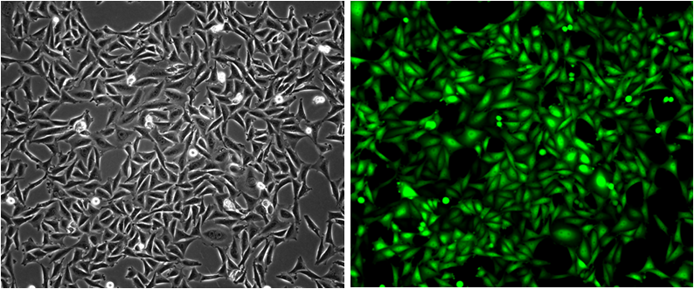Recombinant Human beta-Arrestin 1/ARRB1 (C-6His)
Shipping Info:
For estimated delivery dates, please contact us at [email protected]
| Amount : | 50 µg |
| Content : | Lyophilized from a 0.2 µm filtered solution of 20mM PB, 150mM NaCl, pH 7.2. |
| Storage condition : | Lyophilized protein should be stored at -20°C, though stable at room temperature for 3 weeks. Reconstituted protein solution can be stored at 4-7°C for 2-7 days. Aliquots of reconstituted samples are stable at -20°C for 3 months. |
| AA sequence : | MGDKGTRVFKKASPNGKLTVYLGKRDFVDHIDLVDPVDGVVLVDPEYLKERRVYVTLTCAFRYGREDLDVLGLTFRKDLFVANVQSFPPAPEDKKPLTRLQERLIKKLGEHAYPFTFEIPPNLPCSVTLQPGPEDTGKACGVDYEVKAFCAENLEEKIHKRNSVRLVIRKVQYAPERPGPQPTAETTRQFLMSDKPLHLEASLDKEIYYHGEPISVNVHVTNNTNKTVKKIKISVRQYADICLFNTAQYKCPVAMEEADDTVAPSSTFCKVYTLTPFLANNREKRGLALDGKLKHEDTNLASSTLLREGANREILGIIVSYKVKVKLVVSRGGLLGDLASSDVAVELPFTLMHPKPKEEPPHREVPENETPVDTNLIELDTNDDDIVFEDFARQRLKGMKDDKEEEEDGTGSPQLNNRLEHHHHHH |
Source: E.coli.
MW :48.13kD.
Recombinant Human beta-Arrestin 1 is produced by our E.coli expression system and the target gene encoding Met1-Arg418 is expressed with a 6His tag at the C-terminus. beta-Arrestin-1 (ARRB1) is a cytoplasmic protein that belongs to the arrestin family. ARRB1 is expressed at high levels in peripheral blood leukocytes and the central nervous system. ARRB1 regulates agonist-mediated G-protein coupled receptor (GPCR) signaling by mediating both receptor desensitization and resensitization processes. ARRB1 acts as a cofactor in the beta-adrenergic receptor kinase (BARK) mediated desensitization of beta-adrenergic receptors. ARRB1 is believed to play a major role in regulating receptor-mediated immune functions. ARRB1 is involved in Toll-like receptor and IL-1 receptor signaling through the interaction with TRAF6.
MW :48.13kD.
Recombinant Human beta-Arrestin 1 is produced by our E.coli expression system and the target gene encoding Met1-Arg418 is expressed with a 6His tag at the C-terminus. beta-Arrestin-1 (ARRB1) is a cytoplasmic protein that belongs to the arrestin family. ARRB1 is expressed at high levels in peripheral blood leukocytes and the central nervous system. ARRB1 regulates agonist-mediated G-protein coupled receptor (GPCR) signaling by mediating both receptor desensitization and resensitization processes. ARRB1 acts as a cofactor in the beta-adrenergic receptor kinase (BARK) mediated desensitization of beta-adrenergic receptors. ARRB1 is believed to play a major role in regulating receptor-mediated immune functions. ARRB1 is involved in Toll-like receptor and IL-1 receptor signaling through the interaction with TRAF6.
Always centrifuge tubes before opening. Do not mix by vortex or pipetting. It is not recommended to reconstitute to a concentration less than 100 µg/ml. Dissolve the lyophilized protein in ddH2O. Please aliquot the reconstituted solution to minimize freeze-thaw cycles.
Endotoxin : Less than 0.1 ng/µg (1 IEU/µg) as determined by LAL test.
For Research Use Only. Not for use in diagnostic/therapeutics procedures.
| Subcellular location: | Cytoplasm, Nucleus, Cell membrane, Membrane, Cell projection, Cytoplasmic vesicle |
| Post transnational modification: | The ubiquitination status appears to regulate the formation and trafficking of beta-arrestin-GPCR complexes and signaling. Ubiquitination appears to occur GPCR-specific. Ubiquitinated by MDM2; the ubiquitination is required for rapid internalization of ADRB2. Deubiquitinated by USP33; the deubiquitination leads to a dissociation of the beta-arrestin-GPCR complex. Stimulation of a class A GPCR, such as ADRB2, induces transient ubiquitination and subsequently promotes association with USP33. |
| BioGrid: | 106901. 259 interactions. |
|
There are currently no product reviews
|
















.png)









